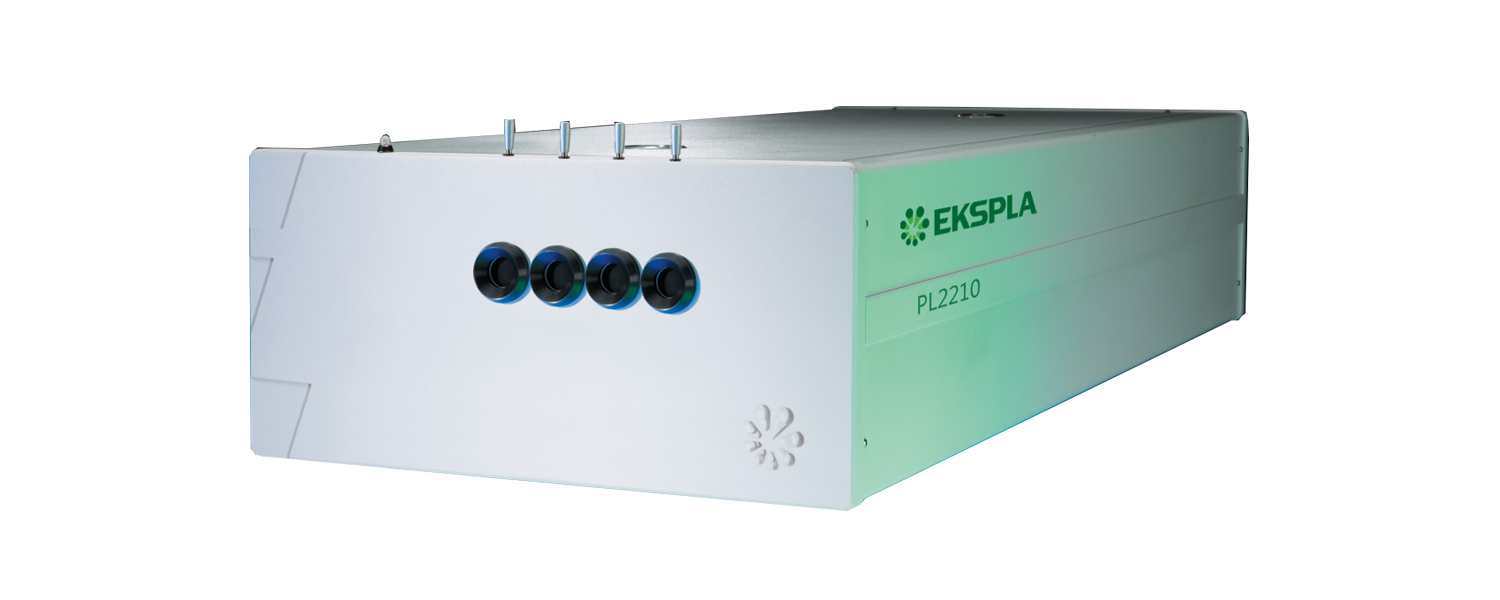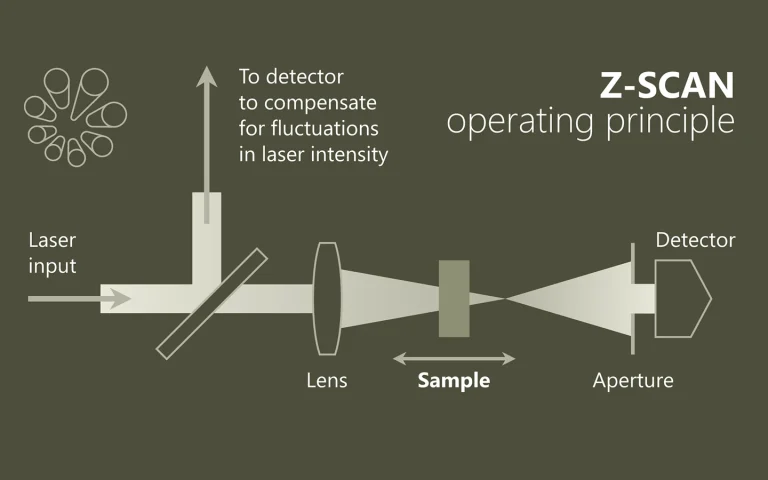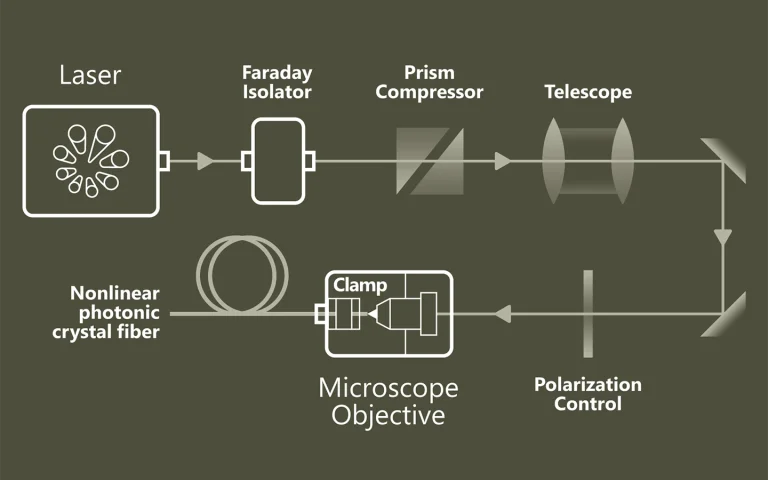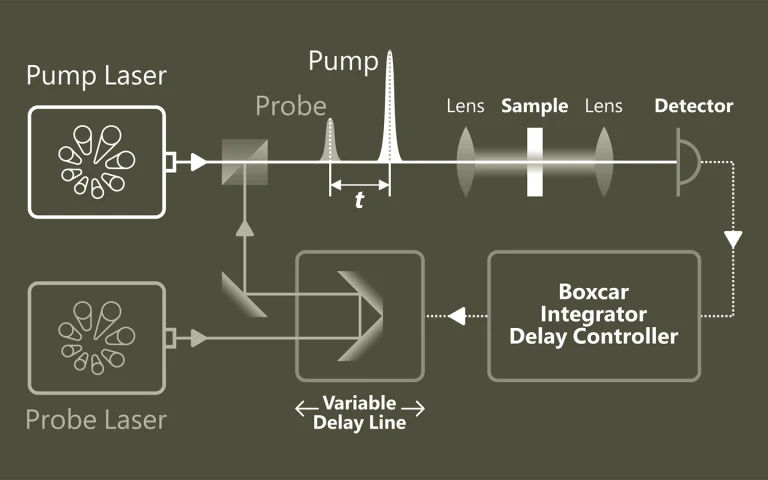PL2210 Series
Diodengepumpte hochrepetierende Pikosekunden Nd:YAG-Laser
Die Systeme der PL2210 Reihe sind dioden-gepumpte, modengelockte und zum Teil rein luftgekühlte Nd:YAG Festkörper-Laser, die Pikosekunden-Pulse bei einer Repetitionsrate von 1 kHz liefern.

Features
- Bis zu 5mJ Pulsenergie bei 1kHz Wiederholrate (höhere Pulsenergie bei Anfrage)
- Diodengepumpt, im solid-state Design
- teilweise rein luftgekühlt (für PL2210A und PL2210B)
- Turn-Key System
- Geringe Instandhaltungskosten
- Optionales Streak-Kamera Tiggern mit Jitter <10 ps rms
- Bedienteil
- PC-Steuerung
- Optional temperaturstabilisierte zweite, dritte und vierte Harmonische
Anwendungen
- Zeit-Aufgelöste Fluoresczenz (auch für Messungen mit Streak Kamera)
- Pump & Probe Spektroskopie
- Pumpen von OPG/OPA/OPO
- Remote Laser Sensing
- Weitere Anwendungen im Bereich der Spektroskopie und nicht-linearen Optik
Anwendungen

Im Brennpunkt der Nichtlinearität
Im Bereich der Nichtlinearen Optik werden mittels Z-Scan beispielsweise der n2-Index (Kerr-Nichtlinearität) oder der Nichtlineare Absorptionskoeffitzient Δα ermittelt. Über die „Open“ und „Closed“ Methode werden dazu sowohl der Realteil als auch der Imaginär-Teil des Nichtlinearen Brechungs-Indexes gemessen.

Supercontinuum “White Light Laser” sind mittlerweile eine etablierte Turn-Key Lichtquelle für eine Vielzahl von Anwendungen von Biomediziner Bildgebung bis hin zur Charakterisierung von optischen Systemen.
Der Vorteil der Verwendung dieser Lasersysteme liegt in der gleichzeitigen Bereitstellung zum einen einer guten Fokussierbarkeit und zum anderen einer hohen Leistung über einen großen Wellenlängenbereich.

Pumpen. Proben. Verstehen.
Die Pump-Probe-Spektroskopie ermöglicht einen tiefen Einblick in ultraschnelle Prozesse auf atomarer und molekularer Ebene. Mithilfe von gepulsten Lasern lassen sich dynamische Veränderungen mit extrem hoher zeitlicher Auflösung verfolgen. Typische Anwendungen liegen in der Untersuchung von Ladungsträgerdynamik in Halbleitern, der Analyse von Elektronentransfer in chemischen Reaktionen sowie der Erforschung lichtinduzierter Phasenübergänge in Materialien.
Anwendungen
Wissenschafliche Veröffentlichungen
Near infrared light induced plasmonic hot hole transfer at a nano-heterointerface
Z. Lian, M. Sakamoto, H. Matsunaga, J. J. M. Vequizo, A. Yamakata, M. Haruta et al., Nature communications 9 (1), 2314 (2018). DOI: 10.1038/s41467-018-04630-w.
Localized surface plasmon resonance (LSPR)-induced hot-carrier transfer is a key mechanism for achieving artificial photosynthesis using the whole solar spectrum, even including the infrared (IR) region. In contrast to the explosive development of photocatalysts based on the plasmon-induced hot electron transfer, the hole transfer system is still quite immature regardless of its importance, because the mechanism of plasmon-induced hole transfer has remained unclear. Herein, we elucidate LSPR-induced hot hole transfer in CdS/CuS heterostructured nanocrystals (HNCs) using time-resolved IR (TR-IR) spectroscopy. TR-IR spectroscopy enables the direct observation of carrier in a LSPR-excited CdS/CuS HNC. The spectroscopic results provide insight into the novel hole transfer mechanism, named plasmon-induced transit carrier transfer (PITCT), with high quantum yields (19%) and long-lived charge separations (9.2 μs). As an ultrafast charge recombination is a major drawback of all plasmonic energy conversion systems, we anticipate that PITCT will break the limit of conventional plasmon-induced energy conversion.
Silk protein nanofibers for highly efficient, eco-friendly, optically translucent, and multifunctional air filters
K. Min, S. Kim, and S. Kim, Scientific reports 8 (1), 9598 (2018). DOI: 10.1038/s41598-018-27917-w.
New types of air filter technologies are being called because air pollution by particulate matters (PMs) and volatile organic compounds has raised serious concerns for public health. Conventional air filters have limited application and poor degradability and they become non-disposable wastes after use. Here, we report a highly efficient, eco-friendly, translucent, and multifunctional air purification filter that is highly effective for reducing air pollution, protecting the environment, and detecting hazardous chemical vapors encountered in everyday life. Uniform silk protein nanofibers were directly generated on a window screen by an electrospinning process. Optical properties (translucence and scattering) of the silk nanofibrous air filters (SNAFs) are advantageous for achieving viewability and controlling the room temperature. Air filtration efficiencies of the fabricated SNAFs could reach up to 90% and 97% for PMs with sizes under 2.5 and 10 μm, respectively, exceeding the performances of commercial semi-high-efficiency particulate air (semi-HEPA) filters. After use, the SNAFs could be naturally degraded. Furthermore, we demonstrate the ability of SNAFs impregnated with organic dyes to sense hazardous and volatile vapors encountered in everyday life.
Ultrafast z-scanning for high-efficiency laser micro-machining
T. Chen, R. Fardel, and C. B. Arnold, Light: Science & Applications 4 (7), 17181 (2018). DOI: 10.1038/lsa.2017.181.
High-throughput laser micro-machining demands precise control of the laser beam position to achieve optimal efficiency, but existing methods can be both time-consuming and cost-prohibitive. In this paper, we demonstrate a new high-throughput micro-machining technique based on rapidly scanning the laser focal point along the optical axis using an acoustically driven variable focal length lens. Our results show that this scanning method enables higher machining rates over a range of defocus distances and that the effect becomes more significant as the laser energy is increased. In a specific example of silicon, we achieve a nearly threefold increase in the machining rate, while maintaining sharp side walls and a small spot size. This method has great potential for improving the micro-machining efficiency of conventional systems and also opens the door to applying laser machining to workpieces with uneven topography that have been traditionally difficult to process.
